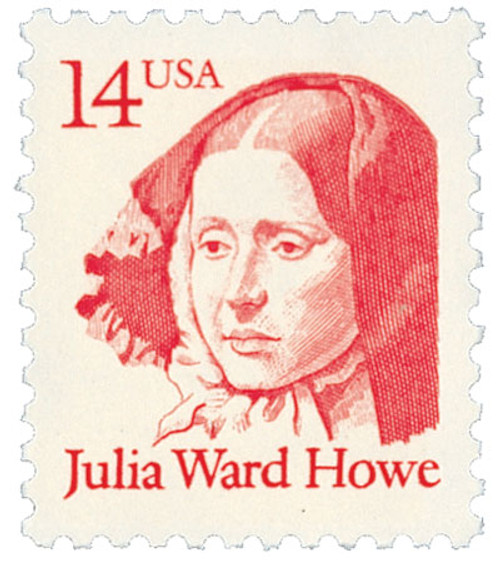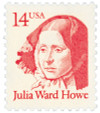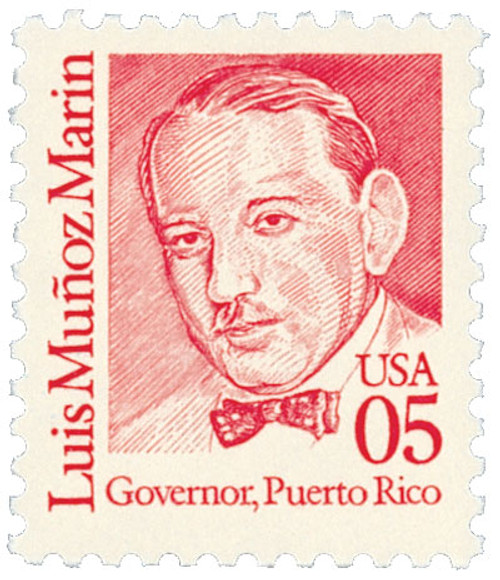
# 2176 - 1987 14c Great Americans: Julia Ward Howe
U.S. #2176
1987 14¢ Julia Ward Howe
Great Americans
- 36th stamp in Great Americans Series
- Issued on the 125th anniversary of the publication of Howe’s Battle Hymn of the Republic, as well as Lincoln’s birthday (and Howe’s tune was his favorite Civil War song)
Stamp Category: Definitive
Series: Great Americans
Value: 14¢, paid the domestic postcard rate
First Day of Issue: February 12, 1987
First Day City: Boston, Massachusetts
Quantity Issued: 429,320,000
Printed by: Bureau of Engraving and Printing
Printing Method: Engraved
Format: Panes of 100 in sheets of 800
Perforations: 11
Color: Crimson
Why the stamp was issued: To replace the 1985 14¢ Sinclair Lewis stamp to pay the domestic postcard rate.
About the stamp design: Ward Brackett produced the pencil sketch for this stamp based on a photo of Howe from around the same time she wrote Battle Hymn of the Republic. This was Brackett’s seventh stamp design and his wife, Dolli Tingle, designed several Christmas stamps.
First Day City: The First Day ceremony for this stamp was held at Dwight Hall in the Howe Building of the Perkins School for the Blind, in Watertown, Massachusetts. The school was originally founded by Howe’s husband, Samuel Gridley Howe, who also served as its director from 1832 to 1876.
About the Great Americans Series: The Great Americans Series was created to replace the Americana Series. The new series would be characterized by a standard definitive size, simple design, and monochromatic colors.
This simple design included a portrait, “USA,” the denomination, the person’s name, and in some cases, their occupation or reason for recognition. The first stamp in the new series was issued on December 27, 1980. It honored Sequoyah and fulfilled the new international postcard rate that would go into effect in January 1981.
The Great Americans Series would honor a wider range of people than the previous Prominent Americans and Liberty Series. While those series mainly honored presidents and politicians, the Great Americans Series featured people from many fields and ethnicities. They were individuals who were leaders in education, the military, literature, the arts, and human and civil rights. Plus, while the previous series only honored a few women, the Great Americans featured 15 women. This was also the first definitive series to honor Native Americans, with five stamps.
The Bureau of Engraving and Printing (BEP) produced most of the stamps, but private firms printed some. Several stamps saw multiple printings. The result was many different varieties, with tagging being the key to understanding them. Though there were also differences in perforations, gum, paper, and ink color.
The final stamp in the series was issued on July 17, 1999, honoring Justin S. Morrill. Spanning 20 years, the Great Americans was the longest-running US definitive series. It was also the largest series of face-different stamps, with a total of 63.
Click here for all the individual stamps and click here for the complete series.
History the stamp represents: Julia Ward Howe was born on May 27, 1819, in New York City, New York to a stockbroker and poet. She received an education from private tutors and attended schools for young ladies until she was 16. One of her brothers traveled to Europe and brought home a library of books that opened her eyes to the world outside of her father’s Calvinist teachings.
In 1843, Howe married physician and reformer Samuel Gridley Howe, with whom she had six children. In her own time, Howe attended lectures, learned foreign languages, and wrote her own plays and stories. Many of her works were published, though they angered her husband, as they often criticized the role of women in society.
In November 1861, Howe and her husband visited Washington, DC. After meeting with President Lincoln, Howe attended a public review of Union troops outside Washington. Among the soldiers was Thomas Bishop, who had joined the Massachusetts militia. Bishop had put together a set of lyrics entitled “John Brown’s Body,” which became a walking song set to the tune of a campfire spiritual, named “Canaan’s Happy Shore” by William Steffe.
Howe awoke in the middle of the night with lyrics for the tune half-composed in her mind. Scribbling in near darkness, she wrote what would become “The Battle Hymn of the Republic.” After being published in the February 1862 issue of the Atlantic Monthly, Howe’s hymn became one of the most popular songs in the Union during the Civil War.
The song, which connects judgment day and the wicked to the Civil War, was published with five verses. A sixth verse was not published originally and is less commonly known. As a result of the song’s success, Howe became the first woman elected to the American Academy of Arts and Letters.
Following the war, Howe went on to become a writer, lecturer, and social reformer for women’s rights. She helped found and served as president of several suffrage groups, including the New England Women’s Club, the New England Woman Suffrage Association, the Association for the Advancement of Women, the General Federation of Women’s Clubs, and the American Woman Suffrage Association. Howe served as editor of the suffragist magazine, Woman’s Journal for 20 years. She also issued an “Appeal to womanhood throughout the world,” which encouraged women from around the globe to strive for world peace.
Howe battled pneumonia and died from it on October 17, 1910, in Portsmouth, Rhode Island. At her funeral, a group of 4,000 people sang “Battle Hymn of the Republic.” After her death, her children wrote a biography about her that won a Pulitzer Prize. She was also posthumously inducted into the Songwriters Hall of Fame and the National Women’s Hall of Fame.
U.S. #2176
1987 14¢ Julia Ward Howe
Great Americans
- 36th stamp in Great Americans Series
- Issued on the 125th anniversary of the publication of Howe’s Battle Hymn of the Republic, as well as Lincoln’s birthday (and Howe’s tune was his favorite Civil War song)
Stamp Category: Definitive
Series: Great Americans
Value: 14¢, paid the domestic postcard rate
First Day of Issue: February 12, 1987
First Day City: Boston, Massachusetts
Quantity Issued: 429,320,000
Printed by: Bureau of Engraving and Printing
Printing Method: Engraved
Format: Panes of 100 in sheets of 800
Perforations: 11
Color: Crimson
Why the stamp was issued: To replace the 1985 14¢ Sinclair Lewis stamp to pay the domestic postcard rate.
About the stamp design: Ward Brackett produced the pencil sketch for this stamp based on a photo of Howe from around the same time she wrote Battle Hymn of the Republic. This was Brackett’s seventh stamp design and his wife, Dolli Tingle, designed several Christmas stamps.
First Day City: The First Day ceremony for this stamp was held at Dwight Hall in the Howe Building of the Perkins School for the Blind, in Watertown, Massachusetts. The school was originally founded by Howe’s husband, Samuel Gridley Howe, who also served as its director from 1832 to 1876.
About the Great Americans Series: The Great Americans Series was created to replace the Americana Series. The new series would be characterized by a standard definitive size, simple design, and monochromatic colors.
This simple design included a portrait, “USA,” the denomination, the person’s name, and in some cases, their occupation or reason for recognition. The first stamp in the new series was issued on December 27, 1980. It honored Sequoyah and fulfilled the new international postcard rate that would go into effect in January 1981.
The Great Americans Series would honor a wider range of people than the previous Prominent Americans and Liberty Series. While those series mainly honored presidents and politicians, the Great Americans Series featured people from many fields and ethnicities. They were individuals who were leaders in education, the military, literature, the arts, and human and civil rights. Plus, while the previous series only honored a few women, the Great Americans featured 15 women. This was also the first definitive series to honor Native Americans, with five stamps.
The Bureau of Engraving and Printing (BEP) produced most of the stamps, but private firms printed some. Several stamps saw multiple printings. The result was many different varieties, with tagging being the key to understanding them. Though there were also differences in perforations, gum, paper, and ink color.
The final stamp in the series was issued on July 17, 1999, honoring Justin S. Morrill. Spanning 20 years, the Great Americans was the longest-running US definitive series. It was also the largest series of face-different stamps, with a total of 63.
Click here for all the individual stamps and click here for the complete series.
History the stamp represents: Julia Ward Howe was born on May 27, 1819, in New York City, New York to a stockbroker and poet. She received an education from private tutors and attended schools for young ladies until she was 16. One of her brothers traveled to Europe and brought home a library of books that opened her eyes to the world outside of her father’s Calvinist teachings.
In 1843, Howe married physician and reformer Samuel Gridley Howe, with whom she had six children. In her own time, Howe attended lectures, learned foreign languages, and wrote her own plays and stories. Many of her works were published, though they angered her husband, as they often criticized the role of women in society.
In November 1861, Howe and her husband visited Washington, DC. After meeting with President Lincoln, Howe attended a public review of Union troops outside Washington. Among the soldiers was Thomas Bishop, who had joined the Massachusetts militia. Bishop had put together a set of lyrics entitled “John Brown’s Body,” which became a walking song set to the tune of a campfire spiritual, named “Canaan’s Happy Shore” by William Steffe.
Howe awoke in the middle of the night with lyrics for the tune half-composed in her mind. Scribbling in near darkness, she wrote what would become “The Battle Hymn of the Republic.” After being published in the February 1862 issue of the Atlantic Monthly, Howe’s hymn became one of the most popular songs in the Union during the Civil War.
The song, which connects judgment day and the wicked to the Civil War, was published with five verses. A sixth verse was not published originally and is less commonly known. As a result of the song’s success, Howe became the first woman elected to the American Academy of Arts and Letters.
Following the war, Howe went on to become a writer, lecturer, and social reformer for women’s rights. She helped found and served as president of several suffrage groups, including the New England Women’s Club, the New England Woman Suffrage Association, the Association for the Advancement of Women, the General Federation of Women’s Clubs, and the American Woman Suffrage Association. Howe served as editor of the suffragist magazine, Woman’s Journal for 20 years. She also issued an “Appeal to womanhood throughout the world,” which encouraged women from around the globe to strive for world peace.
Howe battled pneumonia and died from it on October 17, 1910, in Portsmouth, Rhode Island. At her funeral, a group of 4,000 people sang “Battle Hymn of the Republic.” After her death, her children wrote a biography about her that won a Pulitzer Prize. She was also posthumously inducted into the Songwriters Hall of Fame and the National Women’s Hall of Fame.





















